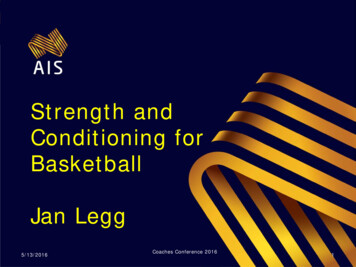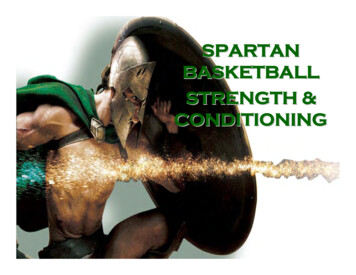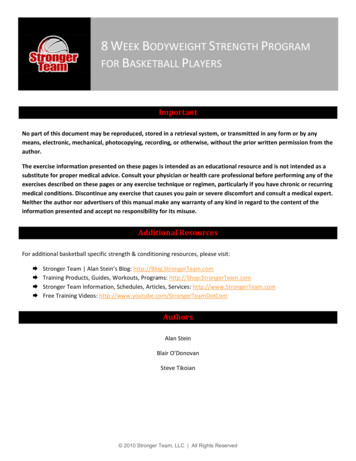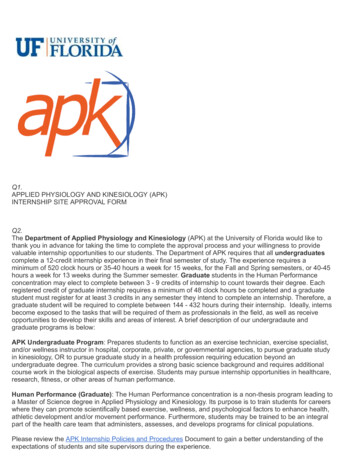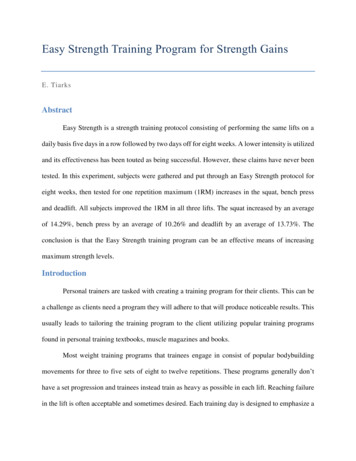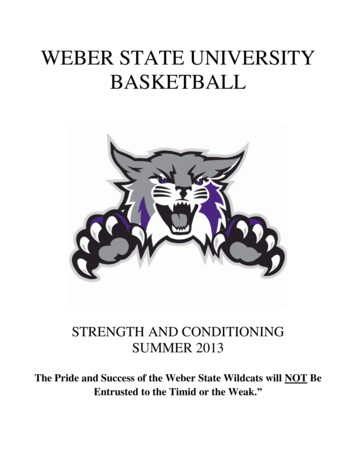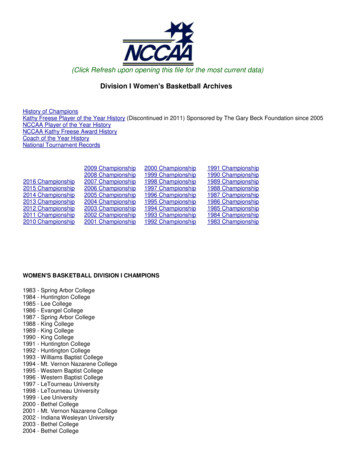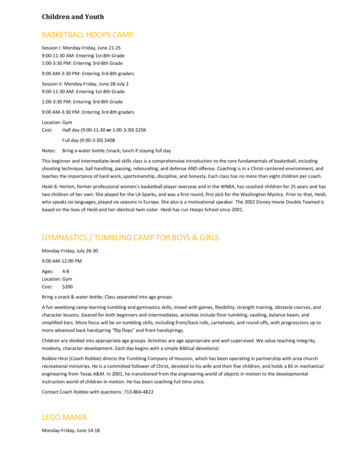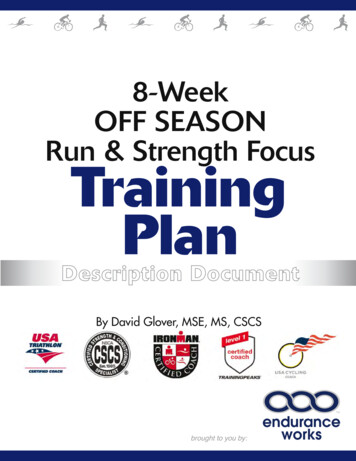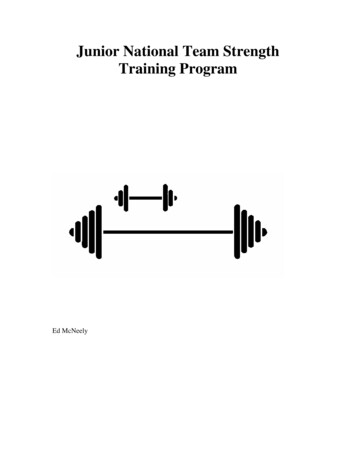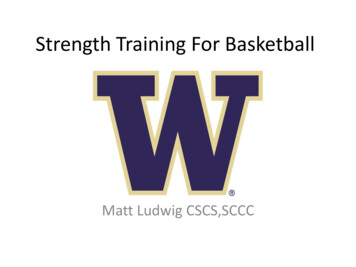
Transcription
Strength Training For BasketballMatt Ludwig CSCS,SCCC
Setting the framework for successHave realistic expectations:1. I want 100% of what you have left everyday2. You must be more concerned with your own development than I am.Provide the athlete a strategy for success:1. Love the game2. Be coachable3. Have a motor.Coach with consistency and intensity.1. Build a plan that addresses the demands of the program2. Establish a testing model that you can measure current and future teams by3. Avoid favoritism4. Be consistent with your discipline and your expectations5. If your excited to train them, they will be excited to train6. Show them you care, be empathetic there is more to life than just basketball.
Two areas physical development and performance trainingbenefit a basketball program. Develop the Individual Develop the team
The individual Strength training increases an individuals value to the team by:1. Building a body that is more resistant to injury.2. Developing motor skills necessary for more efficient movement.3. Improve multi directional force application for greater sprint speed, higherjump heights, more explosive directional changes.4. Improve the body’s ability to absorb these forces to further prevent injury asathletes skill level increases.5. Increasing lean muscle mass.6. Decrease rest and recovery time from individual bouts of effort and long rangebouts of effort.7. Increasing athletes total ability to complete larger volumes of deliberate workday to day- week to week- month to month- year to year.8. Improve individual confidence in ones ability to perform, and handle stress.9. A combination of the above should increase the individuals ability learn morecomplex/advanced training methods providing more usable skills sets ingames, for longer periods of time.
The team In Team Training1. Builds team chemistry to have athletes working together in a commonenvironment under stress working toward common goals.2. Teaches accountability and responsibility.3. Creates a competitive environment where athletes can achieveimmediate tangible feedback of their strengths and weakness’scompared to other teammates.4. Teammates can encourage one another to push through self imposedlimitations for greater sports performance.5. Allows coach an opportunity to praise individual athletes publicly,increasing an athletes drive and motivation to continue working at ahigh level of intensity.6. Provides an environment to develop leadership and help instructleaders how to lead appropriately.7. Teaches teammates how to follow leadership.
What are UW’s key points of emphasis for training abasketball player Starts with program identification:1. Identify common injuries and causes: what areas pose the greatest threatto limiting practice and playing time for the athlete.2. Identify common performance needs of the sport: Define strength, speed,mobility, and endurance needs for the style of play.3. Identify head coach philosophy, practice model, team make up, and howyou will be evaluated on your role within athlete development.4. Identify your available resources- tools- and support systems
Common Injuries and Causes seenat UW– Common injuries :1. Ankles, Knees, Hips (Sprains- Tears- Tendonitis)2. Causes:1. Weak hamstrings and glutes2. Poor proprioception and balance3. Poor mobility in big toe- achillies- hamstrings- hip flexors- piriformisand Lats4. Fatigue, Joint pain, and Poor Movement Mechanics
What do we focus on when we train?1. Fundamental Movement Skills of human movement. Building strength andstability in 3 planes of motion.2. Maximal Sprint Speed3. Sprint speed endurance (anaerobic threshold training)4. Must have a physical presence on both ends of the court, need to be STRONG5. Vertical and horizontal jumping power6. Decrease recovery time between bouts of work creating players that canrecover at the foul line or during time outs.7. Explosive lateral movement and change of directionOur program demands a very high level of work capacity to perform at a high levelfor 40 min or more, especially in the post season of play. We play a game ofcatch us if you can from tip off to the final buzzer, all season long.
Fundamental movements and testing1. Fundamental Movement Skills necessary for athlete assesment.1. Lower Body: Squat 5-3-1RM Testing year round2. Upper Body: Bench Press 10- 5-3-1RM Testing Year Round- and Chin Up Max Rep3. Total Body Strength: Power Clean 3- 1 RM Testing4. Maximal Sprint Speed: 30 yard sprint5. Sprint Speed Endurance: Figure 8 Test6. Agility: NBA Box Agility Test7. Aerobic Endurance: 1 mile run All non injured must run 5:35 or faster8. Vertical Power: Vertical Jump and Approach Jump9. Horizontal Power: Broad Jump and Single Leg Broad Jump10.Total body flexibility: Overhead Snatch Squat11. Limb Length: Height- Reach- Wing Span12. Body weight and Comp testing Guards 6-9% Post 7-11%
Husky training program1. Maximal Sprint speed:1. Max effort lower body strength- core strength- running mechanics2. Front and Back Squat- Clean Pulls- RDLs, Glute Hams and Leg Curls - Step Ups/ Lunges/ SingleLeg Squat- Calf work3. Sled pushes and pulls- foot speed drills, and sprint training.4. Weighted Core work, core endurance work, and Static core work5. Form running and sprint technique training2. Sprint speed and endurance1. Improve lactate threshold, and anaerobic fitness base with lactate threshold training and highintensity speed/ agility work.2. Sled Pushes and Pulls with short rest periods3. Multiple combinations and Supersets for lower body strength training exercises. Creating highlevels of fatigue in a periodized fashion.4. Early in Summer working on a Track- Stadium runs- 100yrd’s of lunges5. Interval Treadmill sprints at varying inclines, Man Maker Treadmill Sprints6. Our overall yearly practice model is up paced and always running.
Husky training program1. Physical Presence on Both ends of the court:1. Train to maximize total body strength and optimal body size through maximal effort work,hypertrophy training, and nutritional couseling.2. Training outside of your comfort Zone to build mental stamina: need to create challenges oftenthat cause an athlete to test courage and willingness to try. Attacking the rim vs OffensiveLinemen, Boxing Glove wrestling matches, Wrestling matches under the rim while trying to scorewith a tennis ball, jumping over a table into high jump pit, man maker runs, waterfall sledpushes, training in gymnastic room, Tough Enough Friday conditioning circuit, get creative.3. Teach them not to give up and never allowing a quitters mentality to enter the room, even if itmeans throwing out the original training plan for the day in an effort to keep the group focused.They have to want to win every day more than you.2. Vertical and horizontal jumping power1. Maximal leg strength, Back Squat- Front Squat- Deadlift- Leg Press- Glute Ham Raises2. Power Training- Power Cleans, Snatches, DB and BB Squat Jumps, Explosive Step Ups, MedicineBall Throws, Box Jumps, Depth Jumps, Bounding, Band Resisted Vertical Horizontal and LateralJumping, Jump and Landing technique training. Any and every way we can overload tripleextension we will explore in training.
Husky training program1. Decreasing rest and recovery needs1. Conditioning should be planned according to the playing season and when being in peakbasketball shape is most important.1. Offseason 1: (April – May) No organized conditioning, open gym, skill work with sportcoaches, and strength training re teaching fundamentals, and going through repairrebuild and retrain2. Offseason 2: (June) no organized team training sessions, athletes have a program 4x perweek weight training, are strongly encouraged to go on vacation, or train on their own.3. Offseason 3: (July) Strength training 4x per week, 2x per week SPARQ Training beforeworkouts 1x general conditioning post workout (treadmill sprint work) . Open gym 5-6xper week, athletes individual workouts on their own 4-6x per week.4. Offseason 4: (August) Strength training 4x per week, SPARQ training 2x per week beforelift, On court moderate intensity conditioning 1x per week, 1x per week on track- footballfield- or stadium preparing for preseason conditioning test and preseason preparationwork. Open gym 5-6x per week, athletes individual workouts on there own 4-6x per week5. Preseason: Strength Training 3x per week, on court conditioning 3x per week, skill workwith coaches 3x per week, open gym 5-6x per week. Test mile at beginning and Figure 8conditioning test at end.6. Inseason: Strength training 2-3x per week 30min sessions, Practices vary from 2-3 hours inlength in early season, during league play 1.5 -2 hours, and 1-1.5 during tournament time,always going 6x per week. NO additional conditioning outside of practice.
Husky training program1. Building explosive lateral movement and change of direction1. speed and agility work with an emphasis on mechanics2. Speed ladders, SPARQ Speed boxes3. Various ½ court agility drills emphasizing basic fundamental movements, slides, sprints to slides,sprint to back peddle, multiple direction training at top speeds, cross over to sprint.4. Skill Specific work, Close Outs, Diving on the floor, Defensive Sliding mechanics, Setting andcoming off screens .2. Very high level of GPP to perform at a high level for 40 min.1. Periodized conditioning plan for the year2. Peak conditioned shape should be in January at start of League play, and maintained throughoutremainder of season3. Offseason builds from no conditioning back into being in shape to start 8 hour per weekpractice sessions in the preseason. We play games November-March not May.4. Preseason 5 weeks of high intensity training focusing on getting in shape to start official practiceand 20 hour per week training sessions.5. Inseason: 1st half adapting to 20 hour per week training sessions, 2nd half in peak shape andneed to enhance basketball skill sets, offensive and defensive strategies, Neck up Training keepthem focused and motivated through the post season. Intensity and Volume management iscrucial during this time period. All conditioning done at basketball practice during inseason.
How: To design the program I stick to several core principals that are continually evolvingas I learn more about the sport, it’s needs, and meeting the demands of thecoaching staff.Core Principals:1.2.3.4.Teach what you knowNever stop learning, Dr.TrippsTry new things that compliment your strength training paradigmEstablish a testing protocol that compliments the physical – mental- and metabolic demands of thesport and get the head coach on board with your training methods.5. Have check points throughout the year to check progress or regression of an athlete. This will giveyou feedback on the quality of your program and allow you to catch problem areas early.6. Establish a category of strong enough, fast enough, mobile enough so you don’t waste effort inyour training model on exercises they have already mastered. (problems with training weak link)7. Leave most of the “Sports Specific” exercises to the sport coaches. Weight room is GPP for theathlete nothing more.8. Be a fundamentals teacher, and get the basic movements mastered relative to each athlete’s ability.9. Always look for ways to catch your athletes doing things right10. Develop a good relationship with your coaches.11. Be honest and truthful all the time with feedback, testing, and evaluating your athletes andexplaining your training model.
Offseason 1: April – end of MayThis offseason’s goals were GET BIGGER, STRONGER, and IMPROVE BALANCE.1. Day 1: Olympic1.2.Warm Up: Jump Rope- Speed Ladder- VMO Band ¼ Squat- MB Upper Body and Torso – BackExtensions and Plate Sit UpsLift: Hang Snatch- Hang Clean- Clean Pulls- Power Clean- Barbell Overhead PressingProgression- Chin Up Variations – 1 arm DB Rows- Core stability work on Foam rolls2. Day 2: Max Strength1.2.Warm Up: Jump Rope- Upper and Lower Body Dot Drills- Band Assisted Rack Squat HoldsLift: Back Squat- Bench Press- Deadlift Variation- Glute Ham Raises- Shoulder ComplexHanging Knee Ups- Bosu Ball Sit Ups – Bridges (Planks)3. Day 3: Balance, Jump Training, Speed/Agility training, Skill work,1.2.3.4.5.Warm Up: Foam Rolling all lower body, and Back- Dynamic warm up with static stretching,Leg Swings.Plyo’s: Skipping forward and back, speed ski hops, ice skaters, bounding, lateral bounding,vertical and broad jump training off 1 and 2 legs/landing on 1 and 2 legs. Focus on Take offand Landing mechanicsSprint mechanics Band Resisted and Assisted Running, and sprint training, Moderateintensity agility work learning how to be more efficient with directional changes, very little isdone at top speeds here.Skill work: Tennis ball handling, tennis ball wall tosses, other drillsBalance work in Gymnastics room on balance beam.
Offseason 1: April – end of May1. Day 4: Upper body building1.2.Warm up: Dynamic Warm Up- Speed Ladder- Core workLift: Max effort Board Press, High Volume Chest Shoulder Tricep/ Round robin Incline Benchand Decline Push up 4-8-4, Century Set with 95-115lbs, Push Up/Incline/Decline Trisets Round Robin Lat Pulls and Rows with high total volume, MB Pull Overs for time, HighVolume Bicep and Tricep, Band Chest Fly and Band External rotations.2. Day 5: Lower Body Building1.2.Warm Up: Lower Body Foam Rolling- Hurdle Drills- Ankle Bands, Band Assist Deep SquatHolds, VMO Band ¼ Squats.Lift: Front Squat/Leg Curl/ Slide Board Tri Set, Single Leg Squat/Plate Lunge/ Quad Pull andReach Tri Set, MB Bench Squat Jumps superset Bosu ball Squat Holds for time, ManualResisted Reverse Hypers superset Straight Leg Drops, Calf Raises.3. Additional work within the week1.2.3.Skill work with coaches and open gymWeekly meetings with sports nutritionGo to school and rest
Offseason 2: June1. Transition:1.First 2 weeks in June off from training to allow for compensation and mental breather.2.
1. Conditioning should be planned according to the playing season and when being in peak basketball shape is most important. 1. Offseason 1: (April – May) No organized conditioning, open gym, skill work with sport coaches, and strength training re teaching fundamentals, and going through repair- File Size: 633KBPage Count: 24Explore further8 Week Bodyweight Strength Program for Basketball Playersdragonhoops.weebly.com8 Week Bodyweight Strength Program for Basketball Playersd2y1pz2y630308.cloudfront.netPreSeason Training for Basketball . - Strength Coach.comwww.strengthcoach.comSPARTAN BASKETBALL STRENGTH & CONDITIONINGcoachjacksonspages.comA Basketball Workout to Help You Get Ready for the. STACKwww.stack.comRecommended to you based on what's popular Feedback
